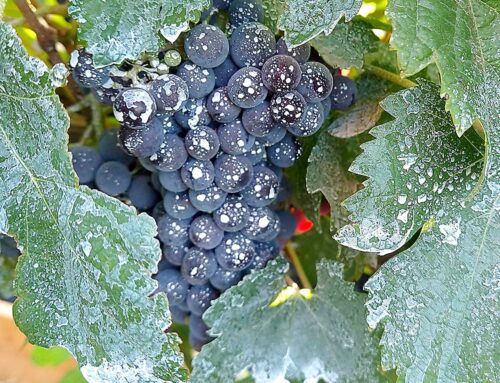Canadian researchers continue looking for more effective packing house sanitation methods. While simple steam still works best in sanitizing bins, other methods are under study for sanitizing cold storage rooms and packing house air. Bin and storage room sanitation is an important element in stopping progression of microbial diseases. Reducing the initial inoculum load through sanitation helps reduce losses in yield due to diseases that show up during storage.
Dr. Peter Sholberg, researcher for the Pacific Agri-Food Research Centre in Summerland, British Columbia, Canada, said that knowing what type and where disease spores are found in the packing house help operators choose the most effective sanitizer. He noted that blue mold, caused by Penicillium expansum, gray mold (Botrytis cinerea), and mucor rot (Mucor piriformis) are three diseases that can be significantly reduced with good packing house sanitation practices.
Sources of gray mold infection include latent infections occurring in the orchard, spores in the orchard air, spores in orchard soil and litter, and spores on fruit. Gray mold spores are not found in packing house air, in the air of cold storage rooms, or in the dump tank. Blue mold sources of infection occur from spores in the orchard air, soil, litter, and on the fruit.
Though the highest concentration of spores is typically found in the orchard litter and soil, spores in the packing house air are the third highest source in terms of spore concentration. Spores are also found in cold storage rooms and on the bins. Contaminated fruit is highly correlated with decay occurring in storage. Mucor rot infection sources are not found in the orchard or packing house air, but they are found in wind fall fruit, orchard soil, and in the dump water. Mucor rot spores disperse primarily in water.
Sanitizers
Sanitizers A variety of sanitizers for cold storage operations are available—water, steam, detergents, gamma ultraviolet radiation, dry air, and chemical sanitizers. Some are better than others against certain organisms, Sholberg said. Earlier research conducted by Dr. Robert Spotts, Oregon State University, showed that applying steam to bins for ten seconds killed 100 percent of blue mold inoculum on plastic bins and 99 percent of the blue mold on wooden bins.
The research compared chlorine compounds, quaternary ammonium compounds (QAC), steam, and SOPP (sodium orthophenylphenate). With chemical sanitizers, pH of the water and the microbial load are important factors in determining their effectiveness. Some can be used as a fog to sanitize the air, in water, or as surface sterilants. Drawbacks to chlorine compounds are that sodium and salts are added to the water, which adds to wastewater concerns.
QAC are inactivated in hard water and don’t work against all microorganisms. A relatively new technology uses ozone for sanitation. Ozone kills bacteria the in water, Sholberg said, but it’s not effective in sanitizing bins. When ozone is used to sanitize the air, sporulation is delayed and ethylene gas may be reduced. “Ozone is good on surfaces, but it doesn’t penetrate well,” he added. In studies that fumigated storage rooms with carbon dioxide, Sholberg said that Penicillium and codling moth were killed, but the most effective responses were observed after fruit was fumigated for 18 days. “This may not be a cost-effective treatment.”
He has also investigated the effectiveness of a new product that uses hydrogen peroxide and peroxyacetic acid. Sold under the brand name StorOx, the sanitizer is applied by cold fogging, a power sprayer, or mop. “The results were quite good, especially if you did two treatments,” Sholberg said about StorOx’s ability to sanitize walls and bins. His research showed the product had a long residual effect—Penicillium spores were nearly absent eight months after treatment. The hot sun is another method that can be effective in killing spores on bins. “No matter what method you use to sanitize bins, they have to be cleaned thoroughly and with water,” he added. “But hot air does work.”
Vinegar vapor
Acetic acid vapor also shows promise as an effective cold storage sanitizer, he said, but added that the material still needs much research. Acetic acid is a simple organic acid that gives vinegar its characteristic odor and flavor. Acetic acid was boiled to turn it into a vapor. Cold storage rooms and rooms with bins were then fumigated with the vapor. “Research shows that no spores were left on the walls after fumigating with acetic acid,” he said.
“However, foam insulation walls were not as easy to sanitize.” Rates still need to be adjusted for sanitizing bins within rooms. Initially, acetic acid was tried as a sanitizing treatment on fruit. After experiments showed problems of fruit burning, scientists began looking at its value for storage applications. Questions about its corrosiveness, rates to use, exposure time, and temperature during application must be answered. “But the acetic acid vapor looks promising if we can get over some of the problems with corrosion,” he concluded.






Leave A Comment